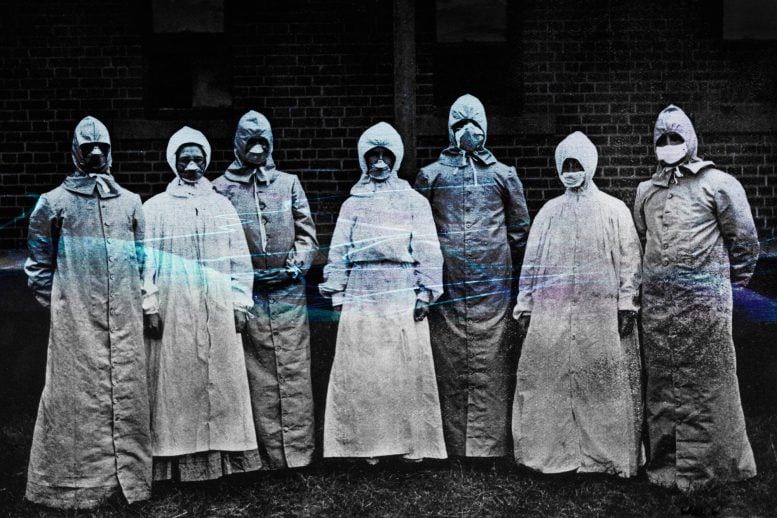Scientists Decode 1918 Flu Virus Genome From Century-Old Tissue
Published: 23 July 2025
By University of Zurich
via the SciTechDaily website

Protective-Suits-Spanish-Flu-777×518
A century-old Swiss flu sample reveals that critical human-adaptations were in place at the pandemic’s WWI-era onset, offering fresh clues to viral evolution and future preparedness. Credit: Shutterstock
Scientists have decoded the Swiss genome of the 1918 flu virus from a century-old specimen, revealing early adaptations for human infection.
Scientists from the Universities of Basel and Zurich have successfully decoded the genome of the influenza virus that caused the 1918–1920 pandemic in Switzerland, using a preserved specimen from the University of Zurich’s Medical Collection. Their analysis shows that the virus had already acquired crucial traits for infecting humans at the very beginning of what would become the most lethal influenza outbreak ever recorded.
The emergence of new viral epidemics continues to pose serious risks to global health. To better prepare for future outbreaks, it is essential to understand how viruses evolve and to study the patterns of past pandemics. The 1918–1920 influenza pandemic, often referred to as the Spanish flu, resulted in an estimated 20 to 100 million deaths around the world. However, scientists have had limited information about how the virus changed and adapted as the pandemic unfolded.
More than 100-year-old flu virus sequenced
Now, an international team of researchers, led by Verena Schünemann—a paleogeneticist and professor of archaeological science at the University of Basel (previously at the University of Zurich)—has reconstructed the first Swiss genome of the 1918 influenza virus.

Emergency hospital in Zurich’s Tonhalle during the so-called “Spanish flu” in November 1918. Credit: Schweizerisches Nationalmuseum, Inventarnummer LM-102737.46
For their study, the researchers used a more than 100-year-old virus taken from a formalin-fixed wet specimen sample in the Medical Collection of the Institute of Evolutionary Medicine at UZH. The virus came from an 18-year-old patient from Zurich who had died during the first wave of the pandemic in Switzerland and underwent autopsy in July 1918.
Three key adaptations in Swiss virus genome
“This is the first time we’ve had access to an influenza genome from the 1918–1920 pandemic in Switzerland. It opens up new insights into the dynamics of how the virus adapted in Europe at the start of the pandemic,” says last author Verena Schünemann. By comparing the Swiss genome with the few influenza virus genomes previously published from Germany and North America, the researchers were able to show that the Swiss strain already carried three key adaptations to humans that would persist in the virus population until the end of the pandemic.
Two of these mutations made the virus more resistant to an antiviral component in the human immune system – an important barrier against the transmissions of avian-like flu viruses from animals to humans. The third mutation concerned a protein in the virus’s membrane that improved its ability to bind to receptors in human cells, making the virus more resilient and more infectious.
→ Read the entire article on the SciTechDaily website here:
External Web Site Notice: This page contains information directly presented from an external source. The terms and conditions of this page may not be the same as those of this website. Click here to read the full disclaimer notice for external web sites. Thank you.



